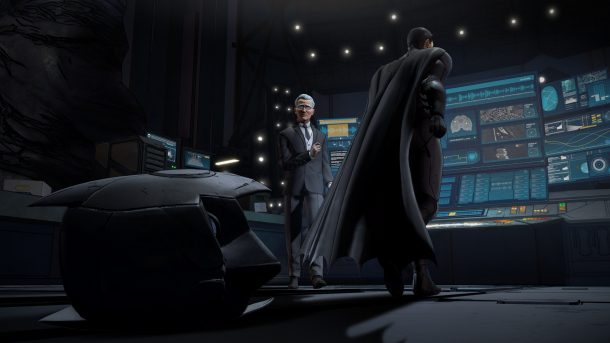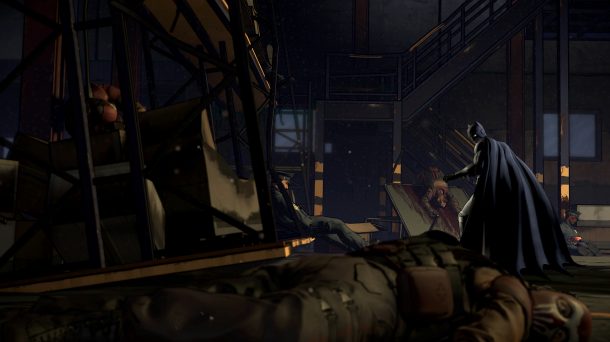Before I played the first episode of BATMAN: The Telltale Series, I was skeptical about what Telltale Games could contribute to the mythos. Batman, of course, is a physical force—one that relies on a fair bit of combat and tech. The dialogue heavy and QTE-based formula of past Telltale titles seemed a strange match for the inimitable hero. How could Telltale could hope to put a new spin on Batman while sticking to their beloved formula?
As it turns out, my skepticism was ill-founded. “Episode 1: Realm of Shadows” not only presents a new take on Batman through its focus on Bruce Wayne, but the core element of choice also enables players to play as their favorite iteration of the character. This results in an experience that, paradoxically, is as fresh as it is familiar.
The episode opens with a well-trodden narrative path for the caped crusader. Batman is trying to get to the bottom of a series of connected crimes. These incidents all involve an encrypted hard drive that multiple criminals (including Catwoman) are vying to obtain. Bruce Wayne, meanwhile, supports Harvey Dent in his campaign as mayor, but inadvertently finds his name connected to that of known-criminal Carmine Falcone. Bruce’s double-life twists and turns about itself, causing him to question both his family’s history and his future as Batman.

These names and conflicts are familiar but well-wrought. Most players know what will become of Harvey Dent; the story flirts with similar expectations about the vexed relationship between Cat and Bat. Despite these recognizable cornerstones of the Batman universe, the episode feels unique for the emphasis placed on Bruce Wayne. Players spend the majority of the episode in his shoes, forcing them to address Alfred Pennyworth’s paternal concern and Vicky Vale’s probing questions in turn. Telltale’s dialogue options allow Bruce to represent himself as a billionaire playboy or soft-spoken philanthropist.
While Bruce steals the spotlight in this episode, “Realm of Shadows” offers plenty of opportunities for players to don the famous bat cowl. At first, I was uncomfortable playing as the Dark Knight. The opening sequence is primarily shown from the perspective of the hapless criminals at Batman’s mercy, and this perspective was at odds with the gameplay, which expected players to recognize patterns in Batman’s stealth attacks. Though the intent was to exhibit the hero’s skills from an outside perspective, the execution was not nearly as smooth as Batman’s take-downs.
After this clumsy opening, the abundant QTEs gave way to much more engaging gameplay. The “link” feature is the episode’s most noteworthy mechanic. During a pivotal seen where Batman investigates a crime scene, linking clues to one another via Bat-tech allows players to solve the crime, thereby returning to Batman’s roots as the world’s greatest detective. The link mechanic also streamlines combat and allows players to direct Batman’s plan of attack. Rather than clues, the “links” are formed between targets and their environment, allowing Batman to drop a giant light fixture on an enemy or send another hurdling through a decorative screen. Establishing these links presents a brief preview of the attack, and this gives players a glimpse of what’s to come before they commit entirely. I found myself changing my links a few times to ensure that Batman’s attack was as stylish as possible.

As they did with Bruce Wayne, Telltale’s signature dialogue options allow players to define the Dark Knight’s character. Though my Batman showed restraint and openly communicated with Commissioner Gordon, I was tempted by options to take a more brutal approach, breaking limbs and crushing skulls to restore order through chaos. Just as players can play as their favorite version of Bruce, so too are Batman’s choices tailored to reflect past representations of the character.
Though there aren’t too many major changes to Telltale’s engine (or their occasional frame rate issues), their usual aesthetic is a solid match for the atmosphere of Gotham City. The bright splashes of color and bold, animated lines contribute to the comic-book feel of the game, and the characters and environments are beautifully detailed. Several scenes are intentionally framed to resemble comic book panels. This was particularly obvious with the Batcave, where the sight of Bruce seated in front of a glowing Bat-Computer gave me a healthy dose of nostalgia. Telltale uses just enough visual shorthand with details like these to make the game feel familiar, even if Gotham City and its inhabitants are rendered in the developer’s characteristic style.
While Bruce Wayne and his alter-ego have been subject to many renditions, never before have fans had the option of choosing their favorite traits. Picking and choosing between several representations gives the story novelty, turning the episode into a veritable sandbox of familiar narrative foundations and characterizations. Most of the typical Telltale fixings are present, but the application of the Batman mythos seems to have mutually rejuvenated both gameplay formula and Batman’s character. “Episode 1: Realm of Shadows” is a promising start to Telltale’s latest episodic series, and it gives me great hope—and enthusiasm—for what’s to come.
This review is based on a copy of the game for Steam sent to SideQuesting by the publisher. Robyn Miller is a veteran of playing Adventure Games, having reviewed several recent Telltale games and modern classics like Life is Strange.


No Comments